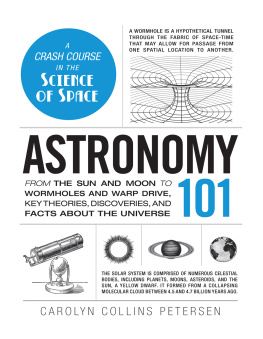1
Introduction
For as long as we humans have been staring up into the starry night sky, we have pondered the mysteries of the universe. The majesty of a still, dark night instills a sense of wonder and awe at the vastness of the universe in which we live. The quiet beauty of a moonlit night, the magical appearance of a shooting star, or the wispy strands of the Milky Way may well cause us to ponder how we humans fit into the grand scheme of things. Perhaps it is the ethereal beauty of the nighttime sky and its propensity for making us wax philosophical that first entice us and generate our interest in astronomy.
It is impossible to say when astronomy really began. Certainly it began before recorded history, making it one of the oldest sciences. Archaeological evidence suggests that our ancestors placed great emphasis upon celestial events with examples abounding throughout the world. Some believe that Stonehenge is the worlds oldest astronomical observatory and may once have been used to predict eclipses. We can look back in time to the ancient Babylonians and see that they had carefully recorded the position of the planet Jupiter and had derived a calendar based upon astronomical events. Farther to the west, the Mayas were intrigued by Venus and left religious monuments that reveal a great deal about their understanding of that planet. Even in modern times, some of our holidays are based upon celestial events like the phase of the Moon. Easter, for example, is the first Sunday following the Full Moon that occurs on or after the vernal equinox (around March 21). In turn, Whitsun Sunday and Trinity Sunday are movable dates because they are tied to Easter.
With the help of only a moderately sized telescope or a good pair of binoculars, looking up into the nighttime sky reveals a breathtaking panorama of galaxies, twinkling stars, colorful nebulae, and mysterious planets. Even when viewed with the naked eye alone, the universe is an enchanting wonderland, but we armchair explorers can do a lot more than merely appreciate the splendors of the nighttime sky. For example, learning the constellations is a rewarding experience that requires nothing more than some memorization and practice at stargazing. The ancient Greeks divided the sky into 48 constellations whereas modern astronomers have divided the sky into 88 constellations. The Greeks cataloged the visible stars within each constellation, and even today, stars are still referred to by the constellation in which they are located as a quick and easy way to approximate their position.

Figure 1.1 The Milky Way Galaxy
Astronomy is a visual science that requires little more than a willingness to be observant. Even without the aid of a telescope, the heavens on a dark night are a stunning sight to behold, as attested by this picture of the Milky Way Galaxy. Measuring some 100,000120,000 light years across, the Milky Way is home to 200 billion stars, in addition to our Sun, the Earth, and all of the objects in our Solar System. (Image courtesy of Dylan ODonnell)
The science of astronomy, especially in modern times, is changing at a rapid rate. New discoveries and advances in related sciences such as physics and chemistry require that we periodically reevaluate our theories about the universe, and even our most fundamental understanding of time and space itself. A striking example is the controversy over Pluto. In 1992 astronomers discovered a region of space beyond Neptune that is filled with trillions of icy objects, many of which are too large to be considered as asteroids but not large enough to be considered as planets. This region of space is the Kuiper Belt, which is estimated to contain thousands of objects that are more than 100 kilometers (62 miles) in diameter. Astronomers at the Palomar Observatory photographed this region of space, and in 2005 they discovered an object approximately the size of Pluto. The discovery of this object, named Eris after the Greek goddess of strife and discord, forced astronomers to revisit the very notion of what it means to be a planet. If Pluto is called a planet, then should Eris take its place as the tenth planet in our Solar System? If Pluto and Eris are designated as planets, then should Ceres, the largest asteroid in the region of space called the Asteroid Belt, also be reclassified as a planet?
To resolve the controversy, in 2006 the International Astronomical Union (IAU) met to formally define a planet. The IAU defines a planet as a celestial body that (a) orbits the Sun, (b) has sufficient mass and gravity to be nearly round in shape, and (c) has cleared the neighborhood around its orbit. The phrase cleared the neighborhood means that the celestial body is gravitationally strong enough to have collected all other nearby matter into its own mass or into moons that orbit the celestial body. When a celestial body has cleared the neighborhood, no other planet-forming debris remains in the vicinity of the celestial bodys orbit.
Alas! Under this internationally accepted definition, Pluto is no longer designated as a planet! Pluto, Eris, and Ceres all fail to meet the cleared the neighborhood criteria. The celestial body formerly known as the planet Pluto is now relegated to the newly created category of dwarf planets. Besides Pluto, 4 other objects within our Solar System are presently classified as dwarf planets: (1) Eris, which has 1 known moon named Dysnomia, (2) Haumea, a football-shaped object that rotates every 4 hours and has 2 known moons, (3) Makemake, which is about two-thirds the size of Pluto, and (4) Ceres, the largest known asteroid and the smallest of our Solar Systems 5 known dwarf planets. The number of objects classified as dwarf planets may well increase in the near future as space probes continue to explore the outer reaches of our Solar System.
It is an exciting time in astronomy with new discoveries being made at a rapid pace as spaceborne instruments scan the far reaches of the cosmos and as space probes and robots arrive at the remotest regions of our Solar System. Most exciting of all, in this authors opinion, is that we may be on the verge of returning to space with manned missions that will far exceed the historic manned trips to the Moon. The purpose of this book is to create a foundation that will allow us aspiring amateur astronomers to join in the fun. The chapters ahead will do so by augmenting our natural ability to observe with the ability to calculate and predict, even if our contributions must remain limited to explorations that can be carried out from our armchairs.
1.1 Accuracy
Before we continue, let us briefly digress to discuss accuracy. Accuracy is a statement of how well a measurement agrees with the actual or accepted value of the entity being measured. For example, suppose a ruler with divisions every inch is used to measure the length of a book, and the result is 8 inches. This number is really only an approximation of the books true length. In reality, is the book closer to 8.1 inches in length, 7.9 inches, or 8.02 inches?
A better measurement could be obtained by using a ruler that has divisions every tenth of an inch. With such a ruler, the books length could be measured to the closest tenth of an inch rather than to the closest inch. Similarly, a ruler could be constructed with even finer divisions, say every hundredth of an inch, to give an even better measure of the length. However, it is easily seen that physical considerations limit how finely a ruler may be subdivided.
Any measurement of a physical entity (such as length, time, or temperature) is by necessity an approximation. Astronomy requires making many different kinds of measurements (e.g., a stars location, the instant a planet passes through some point in space, the distance to the Sun) that must be understood as approximations. This is not to say that all numbers encountered are approximations. The length of a mile is exactly 5,280 feet by definition. There are exactly 1,000 meters in a kilometer. These examples are not approximations because they are exact by definition rather than being the result of some measurement. However, measurements that











